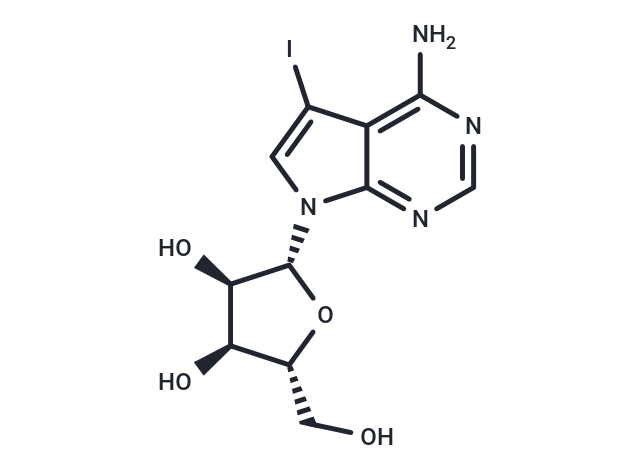Shopping Cart
Remove All Your shopping cart is currently empty
Your shopping cart is currently empty
5-Iodotubercidin (NSC-113939) is a potent adenosine kinase inhibitor with IC50 of 26 nM. It inhibits nucleoside transporter, CK1, insulin receptor tyrosine kinase, phosphorylase kinase, PKA, CK2 and PKC.

| Pack Size | Price | USA Warehouse | Global Warehouse | Quantity |
|---|---|---|---|---|
| 1 mg | $38 | In Stock | In Stock | |
| 5 mg | $93 | In Stock | In Stock | |
| 10 mg | $147 | In Stock | In Stock | |
| 25 mg | $297 | In Stock | In Stock | |
| 50 mg | $476 | In Stock | In Stock | |
| 100 mg | $762 | In Stock | In Stock | |
| 200 mg | $987 | - | In Stock | |
| 1 mL x 10 mM (in DMSO) | $98 | In Stock | In Stock |
| Description | 5-Iodotubercidin (NSC-113939) is a potent adenosine kinase inhibitor with IC50 of 26 nM. It inhibits nucleoside transporter, CK1, insulin receptor tyrosine kinase, phosphorylase kinase, PKA, CK2 and PKC. |
| Targets&IC50 | Adenosine kinase:NA |
| In vitro | 5-Iodotubercidin(Itu) is a genotoxic drug that activates the Atm-p53 pathway and has anti-tumor activity. Itu is unique compared to other nucleoside analogs in the way that it induces G2 arrest in a p53 -dependent manner. Moreover, at higher doses, Itu might activate p53-independent pathways, which may cooperate with p53 to kill cells and inhibit tumor growth. Incorporation of Itu metabolite into DNA causes DNA breaks, which triggers the DNA damage response. Itu might be a potential chemotherapeutic drug with distinct working mechanisms[2]. |
| In vivo | 5-Iodotubercidin is a potent inhibitor of adenosine kinase in the rat brain. 5-iodotubercidin has potent hypotensive, muscle relaxant, and hypothermic actions in mice, and that these effects could be blocked by theophylline, an adenosine receptor antagonist. 5-iodotubercidin (1 mg/kg, i.p.) administered prior to an ischemic episode, fails to provide a degree of cerebroprotection, assessed either by locomotor or histopathological indices Even though 5-iodotubercidin administration is known to enhance extracellular adenosine levels in brain slices[1]. |
| Kinase Assay | AK activity is measured in a radiochemical assay. The final reaction volume is 100 μL and contained 70 mM Tris-maleate (pH 7.0), 0.1% (w/v) bovine serum albumin, 1.0 mM MgCl2, 1.0 mM ATP, 1.0 μM [U-14C]adenosine (400-600 mCi/mmol) and various inhibitor concentrations. Inhibitors are prepared as 10 mM stock solutions in DMSO. The final DMSO concentration in the assay is 5% (v/v). Eleven different concentration of the test solutions ranging from 0.001 to 10.0 μM are utilized to determine a dose response curve of the inhibition of the enzyme. Reactions are started by adding the appropriate amount of purified human recombinant AK and incubated for 20 min at 37°C. The reactions are terminated by addition of the potent AKI GP3269. A 30-μL aliquot of each reaction is spotted on DEAE cellulose filter paper (cut in squares of appr 1×1 cm) and air-dried for 30 min. The dry filters are then washed for 3 min in deionized water to remove residual [U-14C]adenosine, rinsed with ethanol and dried at 90°C for 20 min. The filter papers are counted in 5.5 mL of Ready Safe liquid scintillation cocktail using a Beckman LS3801 scintillation counter. Control AK activity is determined from the amount of [14C]AMP formed in the presence of 5% DMSO. The concentration of inhibitor required to inhibit 50% of the AK activity (IC50) is determined graphically from plots of inhibitor concentration versus percent (%) control enzyme activity. |
| Cell Research | HeLa cells are grown in DME supplemented with 10% fetal bovine serum (FBS) and 2 mM?l-glutamine. Nocodazole is used at a concentration of 3.3 μM unless differently specified. Thymidine (2.5 mM) is used in the asssay. For transfection, FuGENE 6 Transfection Agent is used at a 3:1 ratio with plasmid DNA. Cells are analyzed 24-48 h after transfection. |
| Animal Research | Animal Models: Male Mongolian gerbilsFormulation: salineDosages: 1, 2.5 and 5 mg/kgAdministration: i.p. |
| Synonyms | NSC 113939, 5-ITu |
| Molecular Weight | 392.15 |
| Formula | C11H13IN4O4 |
| Cas No. | 24386-93-4 |
| Smiles | Nc1ncnc2n(cc(I)c12)[C@@H]1O[C@H](CO)[C@@H](O)[C@H]1O |
| Relative Density. | 2.49 g/cm3 (Predicted) |
| Color | White |
| Appearance | Solid |
| Storage | store under nitrogen,store at low temperature | Powder: -20°C for 3 years | In solvent: -80°C for 1 year | Shipping with blue ice/Shipping at ambient temperature. | |||||||||||||||||||||||||
| Solubility Information | DMSO: 19.6 mg/mL (49.98 mM), Sonication is recommended. | |||||||||||||||||||||||||
| In Vivo Formulation | 10% DMSO+40% PEG300+5% Tween 80+45% Saline: 2 mg/mL (5.1 mM), Sonication is recommended. Please add the solvents sequentially, clarifying the solution as much as possible before adding the next one. Dissolve by heating and/or sonication if necessary. Working solution is recommended to be prepared and used immediately. The formulation provided above is for reference purposes only. In vivo formulations may vary and should be modified based on specific experimental conditions. | |||||||||||||||||||||||||
Solution Preparation Table | ||||||||||||||||||||||||||
DMSO
| ||||||||||||||||||||||||||
| Size | Quantity | Unit Price | Amount | Operation |
|---|

Copyright © 2015-2025 TargetMol Chemicals Inc. All Rights Reserved.